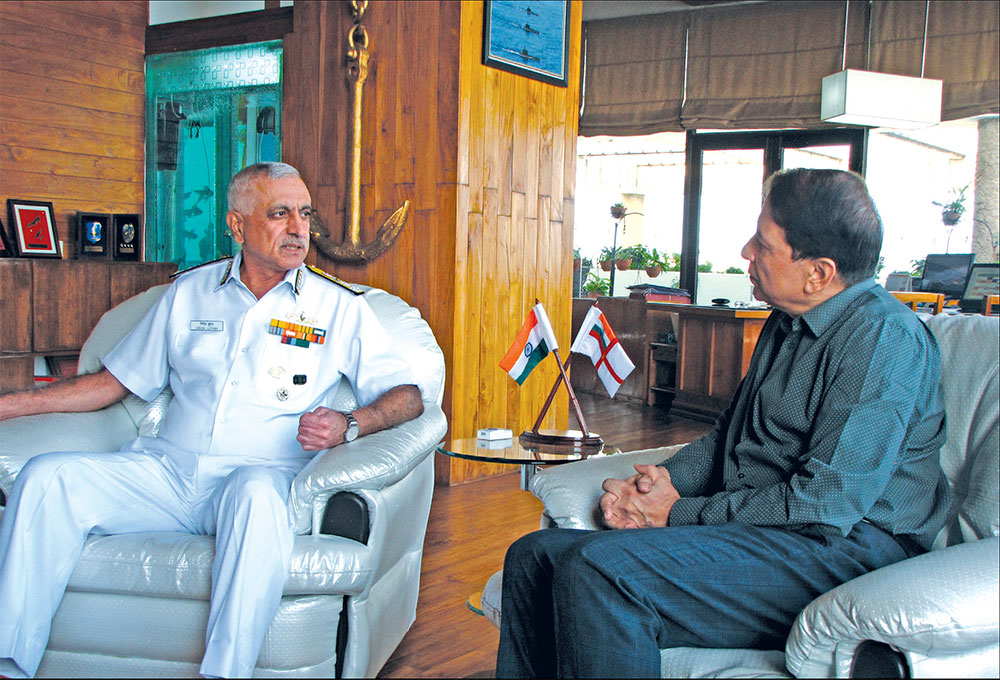Interview | Flag Officer Commanding in Chief, Western Naval Command Vice Admiral Girish Luthra PVSM, AVSM
When your office on the 5th floor overlooks the Arabian Sea, the ocean becomes your playground. In addition to the beautiful vista, it gives Flag Officer Commanding in Chief, Western Naval Command Vice Admiral Girish LuthraPVSM, AVSM a sense of his domain. Anchored just outside his expansive window are ships which are not on operational deployment. Alongside are several patrol craft and tugs. With the sea and his assets laid out in the front and a giant map of the Indian Ocean Region at the back, Vice Admiral Luthra just has to lean back on his chair and get a sense of what opportunities he can exploit and what challenges he needs to be prepared for. There couldn’t have been a better setting for the head of navy’s sword arm.

Editor, FORCE, Pravin Sawhney with Vice Admiral Girish Luthra
The Indian Navy has reoriented its operational deployment pattern now to mission based deployments. What does it mean?
We have now reoriented our deployment patterns, in the sense that we are now undertaking extended long range deployments. We have been doing this for almost a year now. Earlier, we did long range deployments but only once a year. Now, we are doing this at least once every month, and on a regular basis. Now, we frequently have ships and submarines deployed at longer distances. Very recently, we deployed one of our submarines at a long range; and after our ships and aircraft carried out exercises (anti-submarine warfare) with the submarine, it entered the port of Duq’m in Oman. The exercises were carried out in international waters. This was unprecedented, and has set a new precedent.
What are the missions for these deployments, does it include warfare?
Missions are varied and range from anti-piracy to surveillance, deterrence and sometimes showing of presence. Some are also foreign policy-led missions, like EEZ patrolling for friendly littoral states. We do it for Maldives, Mauritius and Seychelles. War preparation calls for some very specific actions. But deterrence is a step before war, and it is included in our missions. For deterrence missions, ships are deployed with full weaponry, especially in the sensitive areas. These are the ships ready for combat. This is done to reduce our reaction time in case of any eventuality, so that they don’t have to come back to the shore to load weapons. These ships are deployed in different areas so that we have a measure of readiness in place.
1
What kind of reaction time do you anticipate between a crisis and its development into war?
We do various war games for this. Given that now we keep certain ships in war-readiness state all the time, depending upon where the crisis emanates from, some ships would be ready immediately. Besides, some ships are always in the harbour in the state of near-readiness. These can move at a short notice to the theatre of operations. We have worked to cut timelines so that our reactions are much faster.
For deployment, one part is logistics and another is planning. Last year, in Western Naval Command (WNC), we set up a standing group headed by a Commodore (one star) for undertaking operational planning and execution. This was long overdue, and has resulted in a greater sense of ownership; since the group undertaking planning, is now also responsible for executing the plans. This group also monitors readiness level of all ships, so as to optimise their deployments. This has resulted in sustained institutional knowledge and continued focus on updating our plans through war-games, table-top exercises and exercises at sea.
more
At any given point what percentage of your ships are deployed at sea?
As a thumb rule, at any given time, 65-70 per cent of our ships are operational. Roughly 30 per cent are under maintenance. However, in case of a crisis, we will be able to pull these out for operations very quickly. Of these 70 per cent, there are some class of ships which are fully ready. On an average, an operational ship spends 75 per cent of its time at sea.
Given that most of your missions in peace time are not for war, how do you then do your training for war-fighting?
Training for war has several stages and follows a sequence. First, you have to get your ships ready, and then coo
Subscribe To Force
Fuel Fearless Journalism with Your Yearly Subscription
SUBSCRIBE NOW
We don’t tell you how to do your job…
But we put the environment in which you do your job in perspective, so that when you step out you do so with the complete picture.








